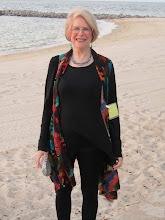Had oodles of fun yesterday learning how to do eco printing. It was an afternoon class offered for SAQA members. There were 6 of us in the class, taught by Molly Koehn, a graduate student at ASU in Tempe.
Molly provided us with most of the fabrics but we were also allowed to bring our own. We used raw silk that was treated with a mordant, a silk/wool blend scarf, and other assorted silk pieces. The first thing we did was walk about the campus and collect leaves and some picked old flowers.
The next step was to choose which fabric we wanted to start with and arrange leaves, etc on half the fabric. We folded over the other half then rolled it tightly around an assortment of items such as dowels and pvc pipe. Someone brought in a piece of copper pipe as well. After it was rolled we tightly wrapped string around it. The idea is to make sure the leaves have as much contact with the fabric as possible. Our bundles were dropped into pot of simmering water and left for an hour. In the meantime, we did up more bundles.
Molly also provided us with a liquid post mordant that she had made up to use with the fabrics that had not been previously treated.
I brought with me a disaster of an experiment using thickened dye on a silk scarf. I figured it was already heading for the garbage heap so I might as well experiment. I am so glad I did. It turned into a beauty.
The results are all over the place. The fabric that was pre-treated had the strongest results, but I am not sure that it wasn't because it was a thicker fabric. I am definitely going to be doing some experiments.
I will be playing around with this technique using a variety of fibers and different mordants, both pre and post.
I had a blast.
Molly provided us with most of the fabrics but we were also allowed to bring our own. We used raw silk that was treated with a mordant, a silk/wool blend scarf, and other assorted silk pieces. The first thing we did was walk about the campus and collect leaves and some picked old flowers.
The next step was to choose which fabric we wanted to start with and arrange leaves, etc on half the fabric. We folded over the other half then rolled it tightly around an assortment of items such as dowels and pvc pipe. Someone brought in a piece of copper pipe as well. After it was rolled we tightly wrapped string around it. The idea is to make sure the leaves have as much contact with the fabric as possible. Our bundles were dropped into pot of simmering water and left for an hour. In the meantime, we did up more bundles.
Molly also provided us with a liquid post mordant that she had made up to use with the fabrics that had not been previously treated.
I brought with me a disaster of an experiment using thickened dye on a silk scarf. I figured it was already heading for the garbage heap so I might as well experiment. I am so glad I did. It turned into a beauty.
The results are all over the place. The fabric that was pre-treated had the strongest results, but I am not sure that it wasn't because it was a thicker fabric. I am definitely going to be doing some experiments.
Raw silk pre-treated
 |
| Raw Silk Pre-treated |
 |
| Redeemed silk scarf |
 |
| Silk/wool blend |
 |
| Sheer silk |
I will be playing around with this technique using a variety of fibers and different mordants, both pre and post.
I had a blast.
















